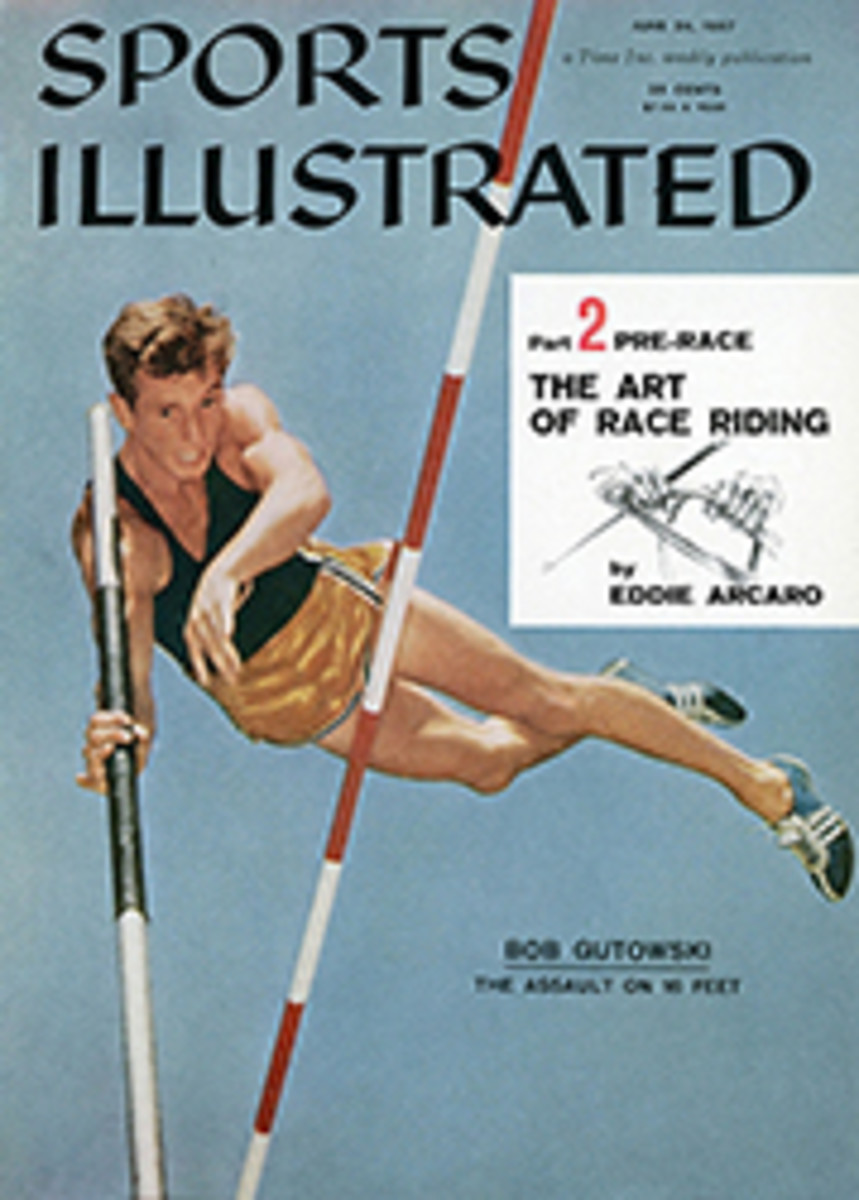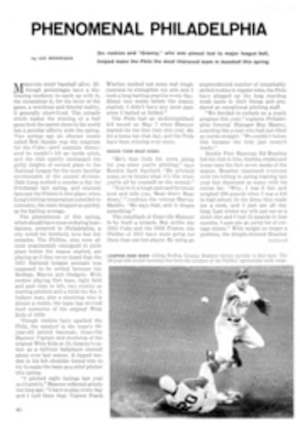
THE MEN LOOK OVER THE BOYS
One may be forgiven for being unaware that the University of California is the 1957 National Collegiate baseball champion or that this honor was attained last week at Omaha, Nebraska, where the Bears beat Penn State 1-0 in the final game of the 11th annual College World Series. And having been so informed, one may still be pardoned for remarking, so what? It is not an event to rank with Waterloo or Hiroshima.
But the baseball-playing colleges, whose numbers have expanded with astonishing rapidity in the postwar decade, point with pride to the renaissance of the great American campus, an area of such peculiarly fascinating pastimes all its own that it has sometimes hardly been aware that people still played baseball any more. This season, however, the fact would have been hard to ignore. Almost 450 four-year colleges and universities played the game, with 10,000 young men on varsity teams alone. Of these schools, 90% classified baseball as a major sport. If not in danger of supplanting football and basketball in the under graduate affection, baseball is at least preparing to take its place at their side.
The big leagues are looking more and more to colleges for the players of the future. This year, of the 400-odd men on big league rosters, approximately a third have some college background. Not all played college baseball, but many did; so many, indeed, that, while famed ex-collegians of the past like Frankie Frisch (Fordham), Lou Gehrig (Columbia) and Ted Lyons (Baylor) were known far and wide as former college stars and frequently so identified, the fact that a big league ballplayer today once attended an institution of higher education is so commonplace that it is practically ignored. It has ceased to be startling to discover books instead of tobacco stains on the floor of a ballplayer's hotel room.
The big leagues can take either book-learning or tobacco juice in stride, as long as the end product is good baseball. They still insist that the best college teams would have real trouble winning against Class C competition, which is the kind you find at Pocatello, Idaho, or Salinas, California or Alexandria, Louisiana, and they say that only a relative few of the very best players are capable of moving off the campus right into Class A, a brand of baseball that is played in Des Moines, Iowa and Jacksonville, Florida and Binghamton, New York.
Yet each year 16 big league teams trample one another in their haste to sign almost 100 college baseball players to professional contracts, and this year they again moved in en masse to watch the cream of the crop at Omaha.
The Municipal Stadium at Omaha, home of the American Association farm club of the St. Louis Cardinals, sits atop a hill on the southeast edge of town, a vantage point occupied frequently in years past by the noble red man who could look out across rolling, wooded park lands toward the Missouri River and wait patiently for the paleface to leave the civilized sanctuary of Council Bluffs for the California gold fields 2,000 miles away. The only Indians around these days, however, come to watch the ball game. They couldn't find a nicer place. Even the gentle fragrance of the vast Omaha stockyards drifts off to the west to caress someone else.
Among the 26,000 who attended the five-day, 14-game double-elimination competition needed to reduce the field of eight district winners to one national champion, the professional scouts stood out like Willie Mays in a Harlem stickball game. Right down front, having paid $1.25 for choice seats just like anyone else, were representatives of all 16 major league teams, the number including not only the scouts themselves but such august front-office personages as Roy Harney of the Phils, Fresco Thompson of the Dodgers, Bucky Harris of the Red Sox, Branch Rickey Jr. of the Pirates and George Selkirk of the A's. There was even a big league manager there briefly for a day; the cards thought so much of one prospect that Fred Hutchinson abandoned his ball club in the heat of a pennant race to fly in from New York and take a look for himself.
Occasionally pausing to swap half-truths with their rivals or drag a red herring through the stands, they concentrated in most cases on some well-scouted and highly recommended young man. In this connection, while a lot of names were mentioned, everyone present was careful to show not the slightest interest in Cal's Earl Robinson, a 190-pounder who moves with catlike grace, runs like a deer, throws like a rifle and hit one baseball almost into downtown Omaha. Despite the casual disinterest, if Robinson failed to sign a fat bonus contract by the end of the week it was only because he was a junior and wanted to go back to school for another year.
Not all the outstanding college players (see box) even made it to Omaha in the first place, of course, but there was little doubt that the best team was certainly there. NCAA officials and writers who have watched them all agreed that George Wolfman's California Bears were perhaps the very best team college baseball has ever seen.
While past tournaments have sometimes been noteworthy for an unusual incident or two, this one will go into history chiefly for the excellent brand of baseball shown, particularly by California, by runner-up Penn State and, to a less consistent degree, by the other two quarter-finalists from Iowa State and Notre Dame. Even the major league umpires who worked the series (Ken Burkhart and Frank Umont) admitted that it was pretty good, although they did complain that the college catchers sometimes stepped on their feet.
California came into the tournament rated below such teams as Texas, the only school ever to win two NCAA baseball championships, Iowa State, Notre Dame and dark horse Florida state, which had eliminated powerful Duke in the regional round.
"It was a break for us," said Wolfman. "While some of the other teams were being praised all over town, they let us alone so we could concentrate on baseball."
The brand of baseball throughout was sometimes studded with brilliance, sometimes flecked with mediocrity. The pitching was superlative. The first three games of the tournament were shutouts—a four-hitter by Harry Taylor of Texas, a three-hitter by Ed Drapcho of Penn State and a six-hitter by Doug Weiss of California—and for a while it appeared that the pitchers had become obsessed with the idea that if you gave up a run you were out. "They must think," said an observer, "they're playing this on the point system." Later, Notre Dame's Chuck Symeon and California's Kim Elliott and George Sterling got into the shutout act, too. The hard-luck young man of the whole affair was Penn State's big sophomore left-hander, Cal Emery, who finally received partial compensation by being named the tournament's outstanding player. When not playing first base, he pitched, allowing a total of only six hits in two games but he gave up a run in each—and the last was the one which cost Penn State the title.
The catching was exceptional, too, and some of the defensive work around shortstop was brilliant, particularly that of Iowa State's little All-America basketball player Gary Thompson, who must have been raised on Frank Merriwell. At times, though, some of the infield play wasn't brilliant at all.
In the outfield there was a fly ball dropped here and there, and a stray throw occasionally wound up at the wrong base. But there were some gems, too. None shone brighter than the day-by-day play of a stocky hard-hitting speedster from California named Bernie Kelly. On the other hand, while every Notre Dame fan in the stands shuddered whenever Jim Morris went back to match wits with a fly ball, no one was able to find much fault with his hitting: 10 hits in 14 at-bats for a .714 average, two home runs, two doubles and eight runs batted in.
California won the tournament quite simply because in almost every category of play it was the superior team. Most important, they had more good pitching and—for a college team—truly remarkable poise. Somewhere along the line most of the other teams lost theirs, perhaps only for an inning, but that was too much. California never did.
[originallink:10476491:42606]
PHOTO
MORNING GAME draws more big league scouts than fans. Cardinals' Runt Marr (with cigar) sits by Dodgers' Fresco Thompson. Behind them is Los Angeles' Dick Walsh.

